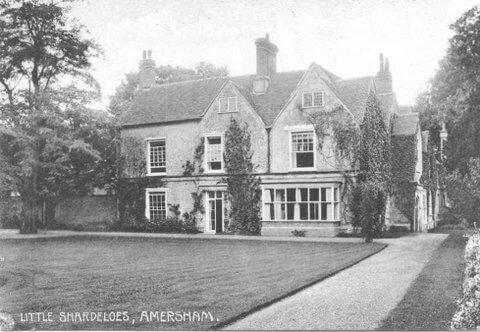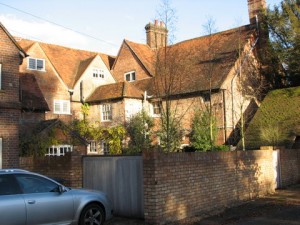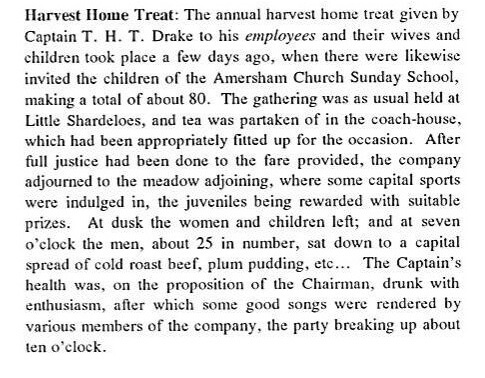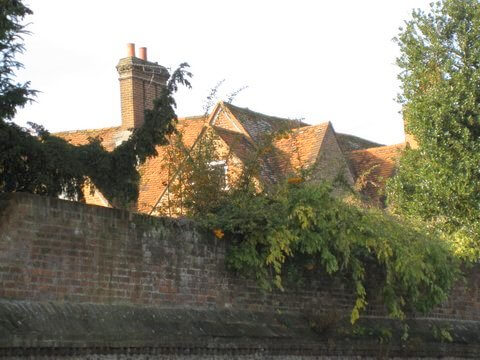
Little Shardeloes is thought to be Tudor in origin. It was purchased in 1652 by William Drake for £240 and used later as the family Dower House (the house available for use by the widow of the owner of Shardeloes or by other members of his family) after it was altered in the 18th century. The high brick wall is believed to have been built in 1688, when it is thought that the timber-framed house was rebuilt in brick as were many English timber-framed houses following the Great Fire of London in 1666.
In 1729, Henry De Chair lived in Little Shardeloes as a tenant of the Drakes. See at the bottom of this page a trancrsipt of his will.
In the 1960s it was sold by the Drake family and divided into three dwellings. Mr Darvill, a carpenter working on the conversion, has told us that when the upstairs floorboards were lifted for treatment, a trap door was found near the fireplace. Was this a “priest hole”?
The house is listed grade II as are the garden wall and entrance gate piers and the ice house in the grounds (see photo in gallery below).
Below is an article about the “harvest treat” in 1893.
Behind the house is The Dower Cottage.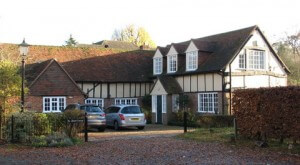 This was possibly the coach house referred to above.
This was possibly the coach house referred to above.
Click on any of the photographs below to enlarge it and to see the description. Then click on forward or back arrows at the foot of each photograph. To close the pictures, just click on one.
The Will of Henry De Chair
This is extracted from the will of Henry De Chair of “Agmondesham, alias Amersham, Gentleman,” dated 19 August 1729 transcribed by Julian Hunt. Henry De Chair was the tenant of the Drakes at Little Shardeloes and insured it for £500 in 1725 (over £100,000 in today’s money).
Having committed his soul “into the hands of Almighty God my most merciful Creator assuredly trusting through the merits and passion of Jesus Christ my most Gracious Lord and Redeemer to enjoy everlasting life” and asking to be interred in St Peter’s Church in Berkhamsted (a relation of his wife had been the Rector there until 1722), he then listed the legacies from “the worldly estate wherewith God hath blessed me”:
- To “my son Lewes De Chair my best Great Bible, my silver tea kettle and lamp and all my family pictures and other pictures in the Great Parlour”
- To “my daughter Mary De Chair the necklace of pearls which were her late grandmother Brabant’s, my fine wrought quill and all my late wife’s child bed linen, my wife’s plain wedding gold ring and my fine set of table linen”
- To “my daughter Elizabeth De Chair my best pair of silver candlesticks, my silver snuff pan and snuffers”
- To “my son Robert De Chair all my silver medals and my three silver castors”
- To “my dear mother Mary Ann De Chair widow the sum of five pounds”
- To “my loving brother the Reverend Mr Edward De Chair and his wife the sum of five pounds apiece”
- To “the Reverend Mr William De Chair, my sister Jane Flahaw and her son Benjamin the like sum of five pounds apiece”
- To “my cousin Susanna Pashall the like sum of five pounds and unto my maid servant Elizabeth Thompson, in case she be living with me at the time of my decease, the like sum of five pounds”
- To “my brother the Edward De Chair my stone ring set with three diamonds on each side of the stone”
- To “my very good friend the Reverend Mr Benjamin Robertshaw Rector of Agmondesham alias Amersham my mourning ring with the words Anna Reg obit Aug 1714 Etat 49 set thereon”
- To “my brother-in-law Benjamin Flahaw all my woollen wearing apparel”
- Fifty shillings (£2.50) each to the parish in which he died and the parish where he was buried
He appointed Rector Benjamin Robertshaw and Mark Thurston, one of the “Masters of the High Court of Chancery”, as his executors to sell his land at Haresfield, in Gloucestershire for the benefit of his children. The two executors were to be paid £25 each.
It was signed and sealed in front of three witnesses (William Ingalton, Richard Bowden and Joseph Child) on “the Nineteenth day of August in the third year of the reign of our Sovereign, Lord George the Second by the Grace of God of Great Britain France and Ireland King, Defender of the Faith, Anno Domini 1729”.

